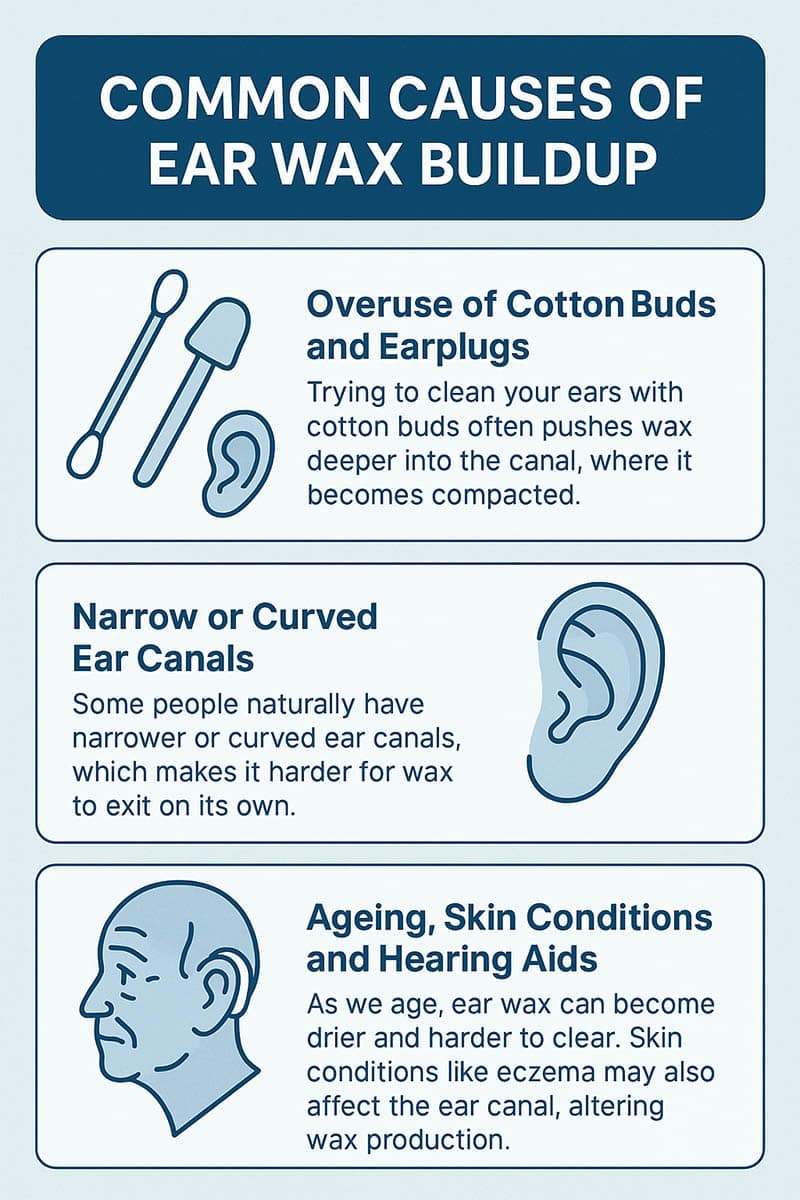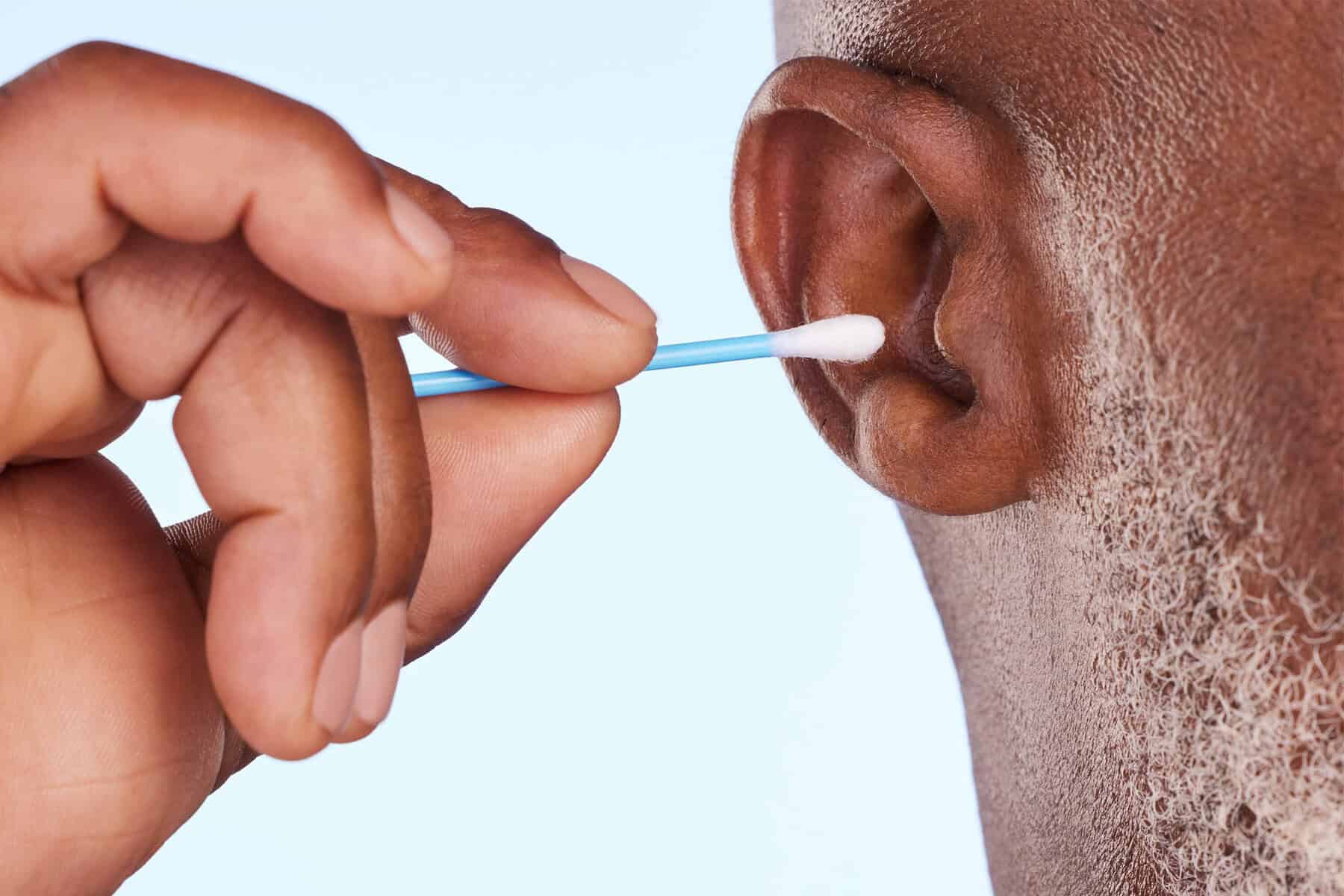Ear wax might seem like a minor inconvenience, but for many people, it can lead to temporary hearing loss, discomfort and even confusion with more serious conditions. At our ear wax clinic, we often see patients who are surprised to learn that a simple build-up of wax can directly affect their hearing. Here you will find the causes, effects and safe solutions for managing ear wax, as well as how to know when it’s time to seek professional care.
The Role of Ear Wax in Ear Health
Ear wax, or cerumen, is produced by glands in the ear canal. It’s a natural substance that plays a crucial role in maintaining ear health by keeping the skin moisturised and trapping dust or small particles before they can reach the eardrum.
Wax forms a protective barrier that helps to reduce the risk of infection by preventing bacteria and fungi from thriving in the ear. It also has lubricating properties, which help prevent dryness and itching.
Problems arise when wax builds up excessively or becomes impacted. This can block the ear canal, leading to a sensation of fullness, muffled hearing and occasionally dizziness or tinnitus. If left untreated, it can interfere with hearing aids or earbud use.
How Excess Ear Wax Can Affect Hearing
Conductive Hearing Loss vs Sensorineural Loss
Excess ear wax is a common cause of conductive hearing loss – where sound is physically blocked from reaching the inner ear. This differs from sensorineural hearing loss, which involves damage to the nerves or structures in the inner ear. While conductive loss is often temporary and treatable, it can be alarming when symptoms appear.
Symptoms of Wax Blockage: Muffled Sound, Pressure and Discomfort
The most common sign is a gradual decline in hearing clarity, often described as muffled or dull sound. Some people also experience a plugged feeling, mild earache or pressure, especially after showers or using earphones. In some cases, wax can also cause ringing in the ears or a sense of imbalance.
How It Can Mimic More Serious Hearing Issues
Because symptoms like hearing loss, tinnitus and pressure overlap with other ear conditions, ear wax blockage can sometimes be mistaken for more serious issues. That’s why a professional examination is so important; helping to distinguish between simple wax build-up and more complex causes.
Common Causes of Ear Wax Buildup

Safe Ways to Remove Excess Ear Wax
Over-the-Counter Drops and Softeners
Pharmacies offer wax-softening drops, often containing olive oil or hydrogen peroxide-based solutions. These can help loosen wax and support natural movement towards the ear opening. However, they are best used under guidance, especially if you have a history of ear problems.
Professional Microsuction and Irrigation Services
Ear wax microsuction is a safe, effective method provided at our ear wax clinic. Using a gentle vacuum, it removes wax without introducing moisture or causing physical trauma. Irrigation, where warm water flushes out the wax, is another option. Both are carried out under clinical conditions by trained ENT professionals.
What NOT to Do: Cotton Buds, Ear Candles and DIY Tools
Avoid inserting any objects into your ear canal. This includes cotton buds, hairpins and ear candles. These methods are not only ineffective but can cause injury, infection or even damage to the eardrum. Safe, professional care is always the best route.
When to See a GP or Audiologist
If you notice any of the following, it’s best to seek help:
- Hearing loss that develops suddenly or gradually
- Persistent feeling of fullness or blockage
- Ear pain or discomfort that doesn’t settle
- Tinnitus or dizziness that could be related to ear issues
- Symptoms that don’t resolve after home treatment
An audiologist will examine the ear canal, confirm whether wax is the issue and advise the safest treatment.
How to Prevent Future Build-Up
Gentle Hygiene and Listening Habits
Rather than cleaning inside the ears, focus on wiping the outer ear with a damp cloth. Let your ears self-clean naturally, and try to limit earbud or earplug use if you’re prone to wax issues.
Regular Check-Ups for Hearing Aid or Earbud Users
If you wear hearing aids or frequently use in-ear devices, regular ear checks can help prevent wax-related interference. Your audiologist will advise on appropriate cleaning routines and maintenance.
Long-Term Management for Prone Individuals
For those who produce excess wax or are prone to blockages, routine microsuction every 6–12 months can be beneficial. Your ear wax clinic will provide personalised care to keep your hearing clear and your ears healthy.
Don’t Ignore Hearing Changes
Ear wax is a common and treatable cause of hearing loss. Acting early can prevent discomfort, reduce the risk of further complications and help rule out more serious conditions. If you’re experiencing changes in your hearing, a visit to a specialist clinic can provide clarity and relief.
Explore Ear Wax Removal at The Forbury Clinic
If you’re struggling with ear wax or symptoms of blockage, our specialist-led ear wax clinic in Reading offers safe, effective treatments like microsuction and irrigation. We’re here to help restore your comfort and hearing.


